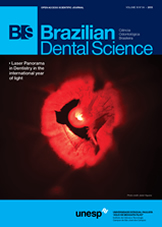Effect of Nd:YAG laser in the bond strength of fiberglass posts
DOI:
https://doi.org/10.14295/bds.2015.v18i4.1164Resumo
The aim of the present study was to compare the effects of Nd:YAG laser application in root canals on bond strengths of fiber posts. Thirty single-rooted bovines were randomly divided into three groups (n=10); root canal instrumentation was performed, and pretreatment was conducted as follows: C group: conventional treatment (without laser irradiation); ALC group: Nd:YAG laser was applied after adhesive; and LAC group: Nd:YAG laser was applied before adhesive. The fiber posts Rebilda 15 DC (Voco) were cemented with an adhesive system and resin cement, in accordance with the manufacturer’s instructions. Six slices with 1.0mm height was obtained for of each root and bond strength was measured by push-out test using a universal testing machine (0.5 mm/min). Data were analyzed using Kruskal-Wallis and Dunn’s tests (p <0.05). Push-out bond strengths to root canal dentin were affected by the type of treatment and root third. The use of Nd:YAG laser after the application of adhesive system had a higher bonding performance compared with the use of laser before the application. Also, cervical and medium third presented higher bond strength values than the apical third. It must be conclude that the laser irradiation over the non-cured adhesive system is more efficient for increase in bond strength than the irradiation after the application of the adhesive. However, the use of 60mJ of laser energy is not sufficient to improve the bonding performance.
Downloads
Downloads
Publicado
Como Citar
Edição
Seção
Licença
TRANSFERÊNCIA DE DIREITOS AUTORAIS E DECLARAÇÃO DE RESPONSABILIDADE
Toda a propriedade de direitos autorais do artigo "____________________________________________________________________" é transferido do autor(es) para a CIÊNCIA ODONTOLÓGICA BRASILEIRA, no caso do trabalho ser publicado. O artigo não foi publicado em outro lugar e não foi submetido simultaneamente para publicação em outra revista.
Vimos por meio deste, atestar que trabalho é original e não apresenta dados manipulados, fraude ou plágio. Fizemos contribuição científica significativa para o estudo e estamos cientes dos dados apresentados e de acordo com a versão final do artigo. Assumimos total responsabilidade pelos aspectos éticos do estudo.
Este texto deve ser impresso e assinado por todos os autores. A versão digitalizada deverá ser apresentada como arquivo suplementar durante o processo de submissão.




























